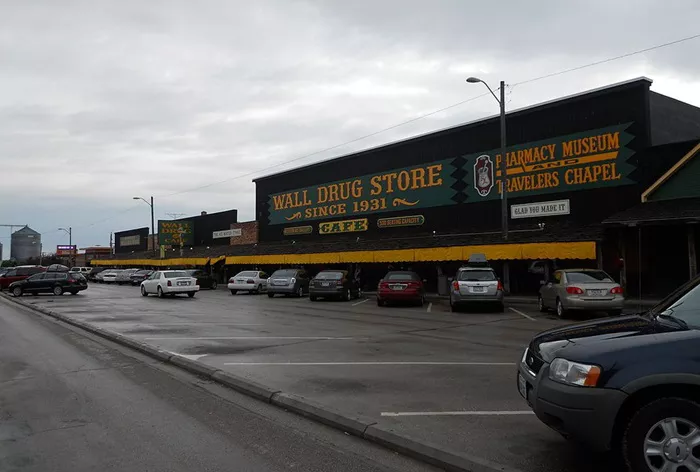Wall, SD – Amid the bustling tourism of Wall Drug, Stacey Schulz finds solace in parking at the rear lot to bypass the crowded Main Street entrances of her local pharmacy.
“During the summer, it’s kind of hectic,” Schulz mentioned, greeting the pharmacist and technician by name.
Schulz’s pharmacy is nestled within Wall Drug, a renowned tourist attraction occupying almost an entire block and attracting over 2 million visitors annually to a town with a population of fewer than 700 residents.
Named after the town of Wall, located just off Interstate 90 near Badlands National Park, Wall Drug’s fame is bolstered by colorful, hand-painted billboards stretching for hundreds of miles. These signs entice motorists with promises of free ice water, 5-cent coffee, and homemade doughnuts. Visitors can pan for gold, listen to singing animatronic cowboys, try on Western wear, and shop for a variety of souvenirs, including plush jackalopes — mythical jackrabbits with antelope horns.
Despite its prime location within a tourist hotspot, Wall Drug’s pharmacy contends with the common struggles faced by independent rural pharmacies. As the only pharmacy in Wall, it serves the local population year-round, including residents who live up to 60 miles away on distant ranches. The closest alternative pharmacy is a 30-minute drive northeast.
Tourists also frequent the pharmacy, needing prescriptions they forgot at home, medications for illnesses encountered on the road, or treatment for injuries sustained while exploring the rugged Badlands. Cindy Dinger, the sole pharmacist at Wall Drug, highlights the diverse needs of their clientele.
Wall has no hospital, but a clinic operates four days a week. Schulz, a medical assistant at the clinic, notes that they often send tourists to Wall Drug for prescriptions. “And then we tell them to get fudge before they leave,” she added.
A study by the Rural Policy Research Institute revealed that from 2003 to 2021, rural pharmacies, especially independent ones, closed at a higher rate than those in urban areas. By 2021, nearly 8% of rural counties were left without a pharmacy. Dinger explained that Wall Drug’s pharmacy has fewer customers than a typical city pharmacy, impacting profitability.
Economic and Operational Hurdles
Dinger pointed out that some prices are higher because Wall Drug cannot negotiate the steep discounts that suppliers offer to chain pharmacies. Rural drugstores also struggle with negotiating leverage with insurers and face increasing competition from mail-order pharmacies.
Staffing is another significant challenge. When Dinger needs time off, she relies on a substitute pharmacist from Rapid City, nearly an hour away. “It’s a challenge getting relief if I want to go on vacation or if I need a cover so that I can go to a doctor’s appointment,” she said. “You take what you can get and try to schedule around it.”
Dinger acknowledged that the pharmacy’s survival is intertwined with the success of Wall Drug. “All this stuff around us — the poster and print shop, the boot shop, the fudge shop, the café — they pay our bills,” she stated.
The pharmacy’s white facade, adorned with stained-glass signs and windows, is modeled after the original drugstore, which was located across the street. Inside, vintage pharmacy supplies, including manuals, glass medicine bottles, and a suppository-making machine, decorate the window displays and top shelves.
Tourists often stop to admire the displays. “It’s a real pharmacy,” one woman remarked, sounding surprised.
Dinger and Sylvia Smith, the only pharmacy technician, ring up customers below a Tiffany-style light fixture and retrieve prescriptions from behind a wooden desk and wall.
Customer Will Lovitt, traveling from Indiana to the Black Hills, visited Wall Drug based on a friend’s recommendation. Lovitt developed a rash during the trip and sought Dinger’s advice for treatment. “It can be difficult for tourists to know where to find medical help, especially when driving through rural states like South Dakota,” he said. “I think it’s time that America gets back to the grass roots of the small-town doctor and the small-town pharmacist.”
Alex Davis, on a road trip from Kansas to Yellowstone National Park, decided to visit Wall Drug and purchased Dramamine to treat car sickness. “When I saw there was a little pharmacy, I thought I’d grab something that I needed,” she said.
Dinger occasionally encounters unique situations, such as a park ranger needing antibiotics after a prairie dog bite. “You never know what kind of diseases they might be carrying,” she noted, referencing a recent outbreak of plague among the animals.
Rick Hustead, chairman of Wall Drug, oversees the store that his grandfather, pharmacist Ted Hustead, opened in 1931. Ted’s wife, Dorothy, had the idea to attract tourists with free ice water and soda fountain advertisements during the Dust Bowl era. Rick’s father, pharmacist Bill Hustead, expanded the store in the ’50s, transforming it into the major tourist attraction it is today.
Though Rick Hustead did not follow his predecessors into pharmacy school, he recruited pharmacists to maintain the pharmacy’s operations. He found Dinger in 2010 after sending letters to every pharmacist in the state.
Dinger, then living in Sioux Falls, was drawn to the opportunity for a small-town life and the appealing work hours at Wall Drug. “We can’t be Wall Drug without being a drugstore,” Rick Hustead said, underscoring the pharmacy’s integral role in the store’s identity.
[inline_related_posts title=”You Might Be Interested In” title_align=”left” style=”list” number=”6″ align=”none” ids=”11083,11065,11063″ by=”categories” orderby=”rand” order=”DESC” hide_thumb=”no” thumb_right=”no” views=”no” date=”yes” grid_columns=”2″ post_type=”” tax=””]


































